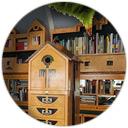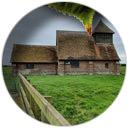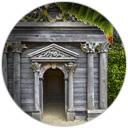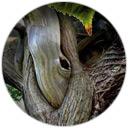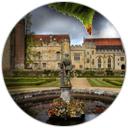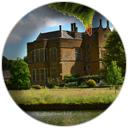The recently opened Cosmic House, in leafy Holland Park’s Lansdowne Walk, transforms a handsome and sober 1840s Victorian brick and stucco villa on the outside into an Arts and Crafts cum Dada cum New Age fantasy on the inside. The house was the brainchild of writer, critic, designer and...
Way out in open fields, with no churchyard of its own, in a parish of marsh, ditches, sheep and cattle, stands the church of St. Thomas Becket. On occasions when the surrounding Romney Marsh floods, the church has appeared to float above the waters. Even high and dry, its location is mesmerizing...
By pure coincidence, my poetry books - loosely ordered alphabetically - are bookended by two slim volumes by Russian poets. In the late 1960s, Penguin Books published their Penguin Modern European Poets series. At 20p a pop these pocket-sized gems were well-worth the spend and did...
Samuel Beckett’s first sight of the words in his head would have been as they flowed from his pen, not as his typewriter’s typebars left their individual ink ribbon marks. His first drafts were in notebooks with a pen (or pencil in the case of Watt). From these handwritten...
Beckett’s How It Is appeared first in French in 1961, then in 1964 after the author had translated it into English himself. Critics generally note that the book’s French title Comment c’est was a pun on Commencer, ‘to begin’, or Commencez !...
When a world expert, who has studied the factors that trigger civil wars globally, gradually realises that these same factors currently exist in the United States, we need to pay attention. So it is with Professor Barbara F. Walter in her book How Civil Wars Start And How to Stop Them...
Beckett finished writing Murphy in June 1936. After 40 rejections by publishers, it was finally accepted in December 1937. At the time, the editor accepting Murphy said, “it is far too good to be a big popular or commercial success … [but] will bring great joy to the few.” The...
Arundel’s castle looms over the town and the River Arun. Its massive bulk - a mix of round and square towers with a curtain wall - dominates the skyline. Parts of it have stood since the 11th century. Others have been added or remodelled in the 18th and 19th centuries. It is one of England...
Croft Castle in Herefordshire in the Welsh Marches, occupies a site of rising and falling fortunes that has been home to the Croft family since the Norman Conquest (save for an interval of just under 200 years). It was first castle, then Elizabethan house, then nearly destroyed in the Civil War...
Old Soar Manor in Kent is a miniscule portion of a small 13th century manor house. Save for a couple of glazed windows, the buildings are open to both weather and birds. Short of a ruin by dint of good roofing, the place is empty. There is no office, entry or ticketing system - or indeed staff....
A painting by Robert Tait in the front parlour of 24 Cheyne Row dated 1857 shows Thomas and Jane Carlyle in their front parlour - at 24 Cheyne Row. Looking at it is like looking through a window into the room in which one is already standing. But the original occupants are there, in painted...
The Baron’s Hall is the older and smaller of two great halls at Penshurst Place in Kent. Completed in 1341, it uses chestnut for the roof because it is lighter but stronger than oak. The main timbers are still aloft there, some six hundred and sixty years later, gnarled and muscular,...
Externally Claydon House in Buckinghamshire is a rather sober place. Its symmetrical west front of seven bays in cut stone suggests conformity to an austere Georgian style of architecture - and no bad thing. Inside, however, if there is such a thing as high rococo, its most extreme form is to be...
The Queen’s House at Greenwich was built for Anne of Denmark, the queen of King James I. Work started in 1616, but Anne died in 1619 and never lived there. The building was completed in 1635 and briefly occupied by King Charles I’s queen consort Henrietta Maria before Civil War...
Downriver from central London’s more eye-catching historic buildings, the Greenwich ensemble known collectively as Maritime Britain is one of Britain’s 33 cultural UNESCO World Heritage sites. It includes the Queen’s House (this site), the Royal Hospital for Seamen and...
Oxburgh Hall in Norfolk is a magnificent brick-built, moated house of great charm. It has been home to the Bedingfield family since the 15th century. The family’s Catholic and Royalist status left them relatively impecunious - a fate which may have inadvertently preserved Oxburgh’s...
Chastleton House in Oxfordshire is a compact Jacobean gem of faded surfaces, bumps and blemishes. Since the early 1600s, its occupants aspired to a status above county gentry but habitually fell short. As Royalists or Jacobites, whose fortunes waxed but mostly waned, their inability to prevent...
Broughton Castle in Oxfordshire is a moated, fortified Tudor manor house. Nikolaus Pevsner, no less, called Broughton “the finest and most complete medieval house in the county” and there’s every reason to agree. Simon Jenkins awards the place a coveted 5 stars in his England’s...
There is much to delight the eye in the newly re-opened Courtauld Art Gallery in London. Although the paintings remain the same within their newly-pristine environment, one sees them more clearly thanks to lighting which is superb, unobtrusively shadowless and encourages close inspection....
Just a hundred miles north-west of Glasgow, where the COP26 conference is being held in November, lies the Inner Hebridean Isle of Coll. With its adjacent sibling Isle of Tiree, it feels less an off-cut of mainland Scotland than a vagrant from the Outer Hebrides, blown in toward the shore. Two...
Dave Goulson’s Silent Earth: Averting the Insect Apocalypse is something of a roller-coaster ride in that the first 250 pages of the book detail the evidence for insect and biodiversity collapse that is happening right now all around us, before lifting our spirits in the final 50...

